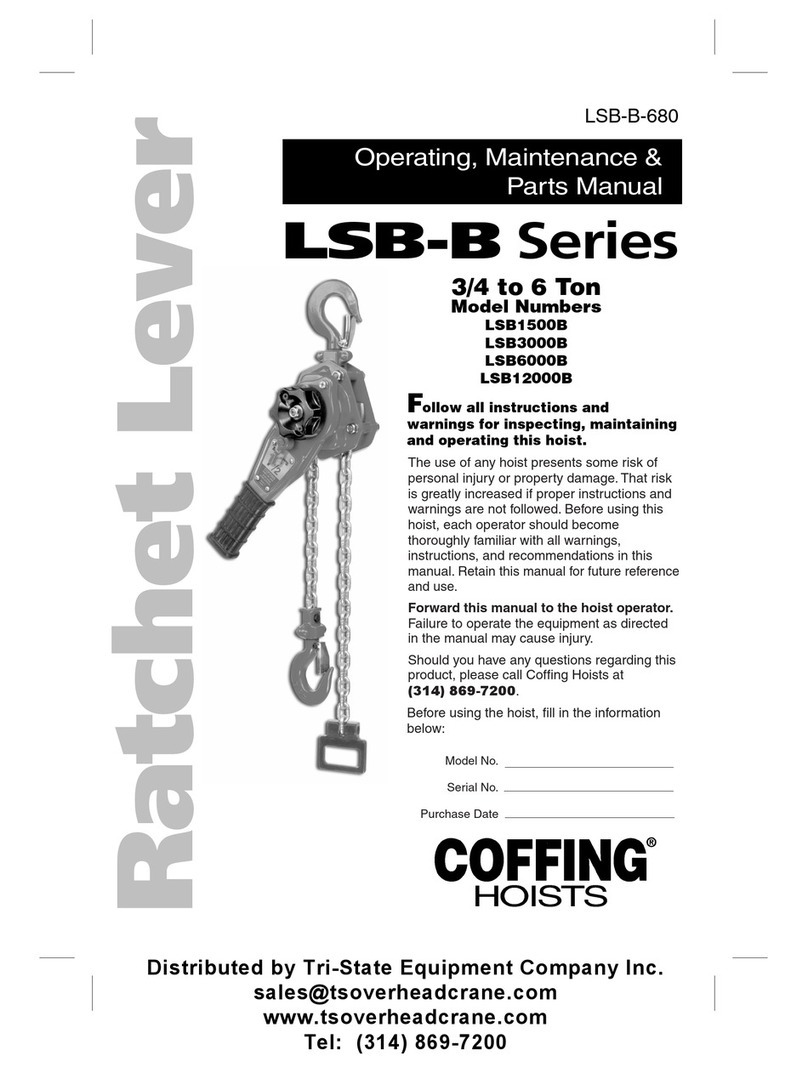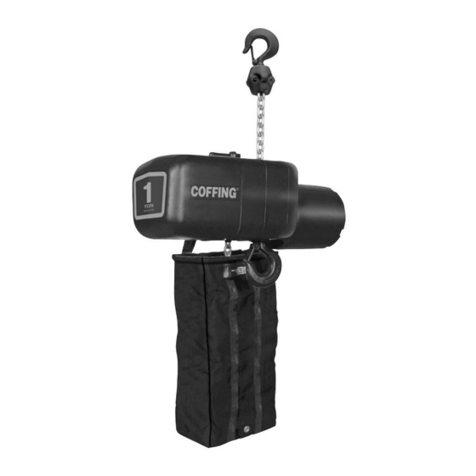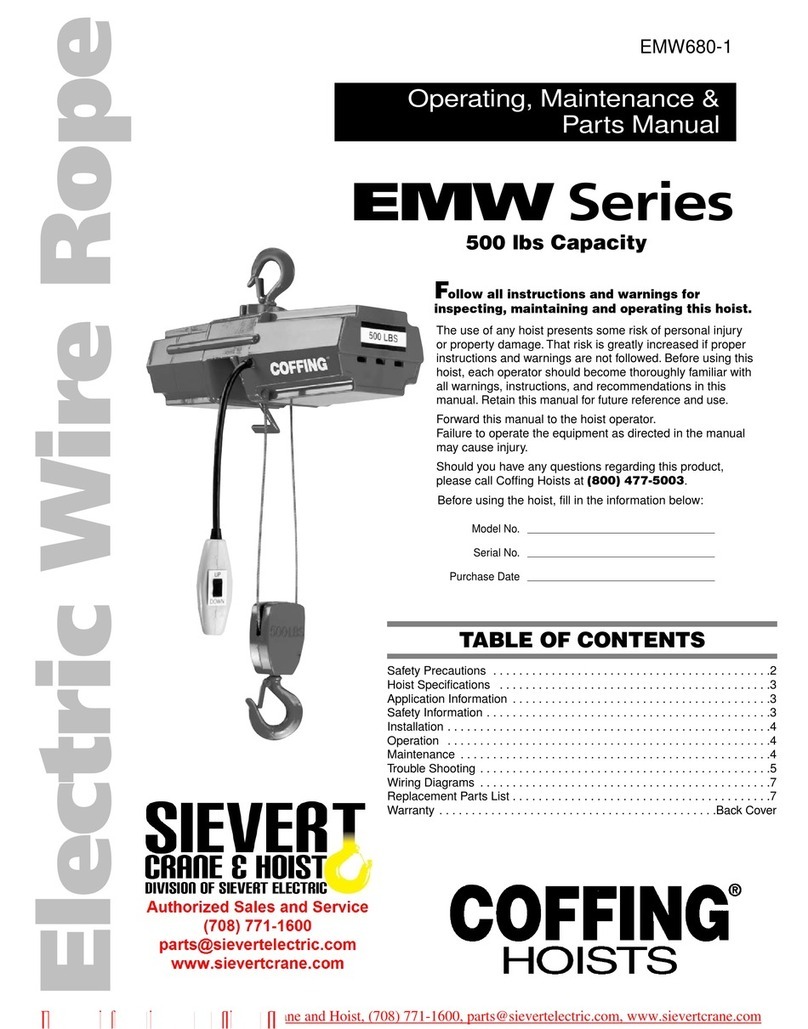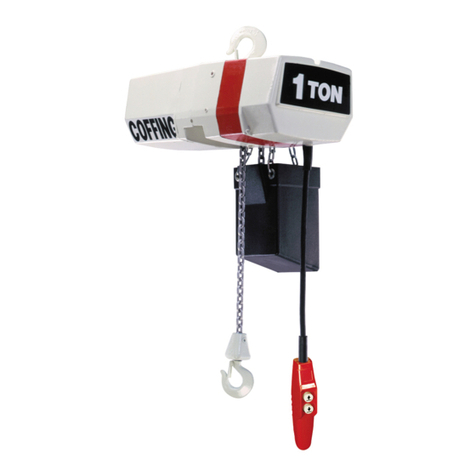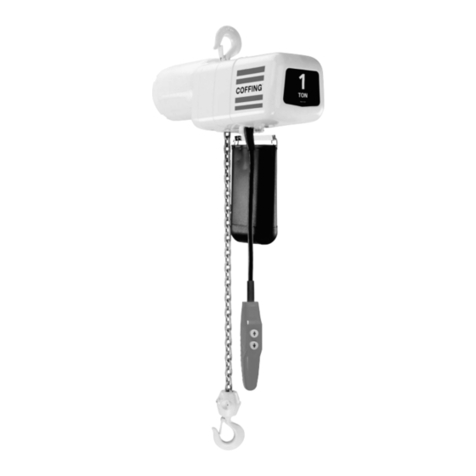
6P/N EC680-7 April 2017
Order # 5041558-0 & 5041679-0
SECTION I INTRODUCTION
1-1. GENERAL INFORMATION
This manual provides information for the safe operation and
maintenance of Cofng® EC-1 Series Hoists. All persons operating
or maintaining these hoists should be familiar with the information
contained herein. Adherence to the precautions, procedures, and
maintenance practices described should ensure long reliable
operation. Suggestions for improvements to this manual are
solicited.
To safeguard against the possibility of personal injury or property
damage, follow the recommendations and instructions of this
manual. This manual contains important information for the correct
installation, operation, and maintenance of this equipment. All
persons involved in the installation, operation, and maintenance of
this equipment should be thoroughly familiar with the contents of this
manual. Keep this manual for reference and further use.
To avoid personal injury:
Do not use the equipment shown in this manual to lift, support,
or otherwise transport people, or to suspend unattended loads
over people.
1-2. SAFETY STANDARDS
All persons concerned with the installation, operation, inspection
and maintenance of these hoists are urged to read ASME B30.16.
That Standard contains valuable guidelines concerning practices
designed to minimize hazards associated with the use of overhead
hoisting equipment. ASME B30.16 also contains detailed procedures
for establishing hoist inspection and maintenance programs and can
be of signicant assistance in maintaining compliance with OSHA
regulations.
1-3. HOIST CONSTRUCTION AND FEATURES
Strong, lightweight aluminum alloy die castings provide a compact,
protective enclosure for the mechanical and electrical components
of Cofng EC-1 Series Hoists. Heat treated alloy steel gearing
operates in an oil bath to provide the most reliable lubrication and
effective heat dissipation .
EC-1 Series Hoists incorporate the following features:
a. Overload limiting clutch.
b. Completely independent mechanical and electrical brakes.
c. Adjustable limit switches.
d. Tough, nylon weather resistant pushbutton stations.
e. Steel strain cable inside pushbutton cord.
f. Transformer isolated, low-voltage pushbutton controls.
g. Quick voltage conversion on dual-voltage units.
TABLE 1-1. BASIC HOIST DATA
Model No. Rated Load
(lb.)
Lift Speed at Rated
Load (ft. per min.) Motor HP
EC-0516 500 16 1/4
EC-0532 500 32 1/2
EC-0564 500 64 1
EC-1009 1000 9 1/4
EC-1016 1000 16 1/2
EC-1032 1000 32 1
EC-2004 2000 4 1/4
EC-2008 2000 8 1/2
EC-2012 2000 12 1
EC-2016 2000 16 1
EC-4006 4000 6 1
EC-4008 4000 8 1
EC-6005 6000 5 1
1-4. BASIC HOIST DATA
The basic hoist models covered by this manual are listed in Table 1-1.
1-5. APPLICATION INFORMATION
This hoist is intended for general industrial use in the lifting and
transporting of freely suspended material loads within its rated
load. Prior to installation and operation, the user should review his
application for abnormal environmental or handling conditions and
to observe the applicable recommendations as follows:
a. Adverse Environmental Conditions. Do not use the hoist in
areas containing ammable vapors, liquids, gases or any
combustible dusts or bers. Refer to Article 500 of The National
Electric Code. Do not use this hoist in highly corrosive, abrasive
or wet environments. Do not use this hoist in applications
involving extended exposure to ambient temperatures below
-10°F or above 130°F.
b. Lifting of Hazardous Loads. This hoist is not recommended
for use in lifting or transporting hazardous loads or materials
which could cause widespread damage if dropped. The lifting
of Ioads which could explode or create chemical or radioactive
contamination if dropped requires fail-safe redundant
supporting devices which are not incorporated into this hoist.
c. Lifting of Guided Loads. This hoist must not be used in the
lifting of guided loads, including dumbwaiters and non-riding
elevators. Such applications require additional protective
devices which are not incorporated into this hoist. Refer to
your state and local regulations governing the requirements for
elevator and dumbwaiter installations.
1-6. WARRANTY
Every hoist is thoroughly inspected and tested prior to shipment
from the factory. Should any problems develop, return the complete
hoist prepaid to your nearest Cofng Authorized Warranty Repair
Station. If inspection reveals that the problem is caused by defective
workmanship or material, repairs will be made without charge and
the hoist will be returned, transportation prepaid.
This warranty does not apply where: (1) deterioration is caused by
normal wear, abuse, improper or inadequate power supply, eccentric
or side loading, overloading, chemical or abrasive actions, improper
maintenance or excessive heat; (2) problems resulted from repairs,
modications or alterations made by persons other than factory
or Cofng Authorized Warranty Repair Station personnel; (3) the
hoist has been abused or damaged as a result of an accident; (4)
repair parts or accessories other than those supplied by Cofng are
used on the hoist. Equipment and accessories not of the seller's
manufacture are warranted only to the extent that they are warranted
by the manufacturer. EXCEPT AS STATED HEREIN, COFFING
MAKES NO OTHER WARRANTIES, EXPRESS OR IMPLIED,
INCLUDING WARRANTIES OF MERCHANTABILITY AND FITNESS
FOR A PARTICULAR PURPOSE.
SECTION II INSTALLATION
2-1. SAFETY NOTES
a. Inspect the hoist for any evidence of shipping damage
or loose parts.
b. The supporting structure and load attaching devices should
have a load rating at least equal to that of the hoist.
c. This hoist is not suitable for use in uncovered outdoor locations
or areas containing explosive dust, vapors or gases.
d. The installation area must provide safe operating conditions
for the operator, including sufcient room for the operator and
other personnel to stand clear of the load at all times.
e. In areas where slack chain hanging from the hoist may create
a hazard, use a chain container (see Figure 2-2).
2-2. HANGING THE HOIST
Hook mounted hoists can be used with a variety of trolleys or
stationary hangers. It is recommended that a hand-geared or
motorized trolley be used when the pulling effort required to move
the hoist exceeds 100 pounds or when the application requires
frequent movement of the hoist.
